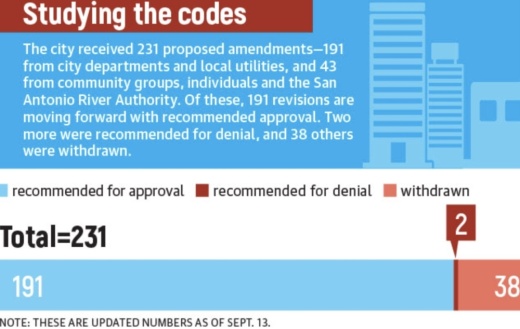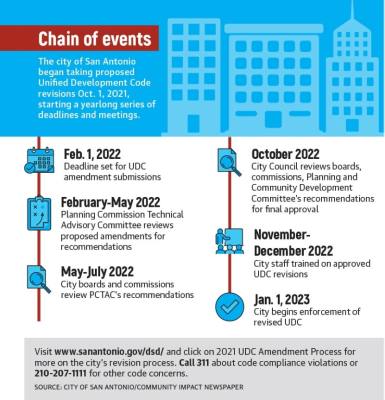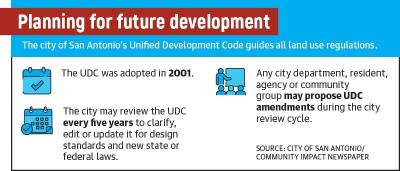The city of San Antonio is almost finished with a yearlong, periodical effort to update the local Unified Development Code, which covers rules, policies and procedures for land development citywide.
Local officials said they are moving forward with 193 of 231 total UDC amendments that were proposed by city staff, commissions and boards, area public agencies, utilities, community organizations, and individual residents between October 2021-February 2022.
Many proposed revisions affect regulations addressing issues, such as new and existing development, especially drainage runoff and construction in floodplains; building or preserving residential accessory dwelling units; and limiting short-term rentals.
According to local officials, City Council expects to review and act on final recommendations in October, and city staff will spend November and December training on UDC changes before they take effect Jan. 1, 2023.
District 8 Council Member Manny Pelaez said updating the UDC every five years helps a growing city, such as San Antonio, ensure any and all approved development maintains the character, well-being and safety of the surrounding community.
Pelaez also said code amendments help eliminate or reduce unnecessary development-related costs.
“Revising the UDC also ensures standardization. We want to standardize rules for everyone across the board,” Pelaez added.
Suggesting changes
Development Services Director Michael Shannon said this UDC review cycle was supposed to happen in 2020, but it was delayed by the COVID-19 pandemic.
Regardless, the UDC review lets the city catch up with new federal and state laws as well as development patterns and challenges in the regulatory process, he said.
“San Antonio is rapidly growing, significantly. We want to make sure, as it develops, it does so in a safe, orderly manner,” Shannon said.
Logan Sparrow, policy administrator with the city’s development services department, informed North Side residents about the UDC revision process in a July 26 public meeting at Phil Hardberger Park.
According to Sparrow, the city’s planning, zoning, and historic and design review commissions as well as the board of adjustments collectively recommended approving 191 amendments.
The same boards and commissions rejected another five proposed revisions; the remaining 33 proposals were later withdrawn, Sparrow said, adding that 11 city departments and offices originally submitted 173 amendments.
“That’s fairly typical. In the UDC amendment process, these are city departments working with this code Monday through Friday, 7:45 a.m. to 4:30 p.m. That’s their full-time jobs, so we are the ones who are often on the front lines dealing with issues and conflicts in our code,” Sparrow said.
Sparrow also said total withdrawals were instances where a person or group saw that their proposal was similar to another sender’s submission.
“Those people withdrew their amendments because we don’t need four versions of the same one definition,” Sparrow said.
In the 2015 UDC review cycle, city officials said they received 296 total proposed amendments and approved 205 changes.
Shannon said he was impressed by the number of individuals and groups who took part in the new review cycle.
“By far, this is the most [engagement] that I’ve seen,” Shannon said.
Secondary homes, short-term rentals
According to city officials, there were lengthy board and commission discussions and public comments surrounding proposed amendments affecting issues, such as accessory dwelling units—or ADUs—and short-term rentals.
One submittal from the city’s neighborhood and housing services department and housing commission offers multiple changes to rules affecting ADUs—smaller, secondary home structures built on a single-family residential property—city officials said.
Such changes increase the maximum ADU size from 800 square feet to 1,600 square feet, cap ADUs’ height at two stories and loosen limits on the number of bedrooms.
Supporters of ADU rule changes, such as Leilah Powell, Local Initiatives Support Corporation San Antonio executive director, said the revisions will enable local homeowners to convert and preserve ADUs on their properties and provide for more affordable housing options citywide.
“ADUs provide opportunities to stabilize homeownership through passive rental income, create more affordable options for renters, prevent displacement for older San Antonians seeking to age in place and allow families to offer supportive living options for those with disabilities,” Powell told the planning commission.
Tier One Neighborhood Coalition, an alliance of multiple inner-city San Antonio neighborhoods, offered amendments affecting matters, such as improved community engagement, new height limits in specific residential areas and limiting short-term rentals.
Regarding short-term rental properties—another topic of contention, city staff said—the TONC proposes removing the word “face” from the term “block face” in a zoning rule for short-term rentals where the property owner/operator resides on the property.
City officials said this verbiage change could further limit the number of short-term rentals allowed on a single residential block.
Several property owners and advocacy groups, such as the Short Term Rental Association of San Antonio, oppose this proposal, saying no evidence supports what they fear is a big change to the existing city short-term rental law.
“Additionally, such changes might negatively impact the short-term rental business in San Antonio, which generates substantial tax and tourism revenues,” STRASA Board Member Shelley Galbraith told the zoning commission July 5.
At the July 26 meeting in Hardberger Park, some attendees said they want the city to strengthen its short-term rental law.
“The city is working against the neighborhood ... working not for us, but working for [out-of-town visitors],” said Marilyn Choate, president of the local Huntington Place Homeowners Association.
According to the city’s four-year-old short-term rental law, property owners must apply for a permit to run such a dwelling in any residential zoning district or one of seven commercial or office zoning districts. Shannon said he feels the city’s four-year-old short-term rental law provides a balanced approach to a contentious topic.
Pelaez acknowledged constituents’ frustration with short-term rentals, but said a 2018 Texas Supreme Court ruling favoring a Houston short-term rental property owner makes it harder to bolster local rules.
“We wrote the strongest possible ordinance that can survive a court challenge. Our short-term rental ordinance has been adopted all over Texas and is held up as the gold standard,” Pelaez added.
Drainage, development and costs
While many residents are concerned with UDC changes that would affect housing, the update will also address new development in flood plains.
Greater Edwards Aquifer Alliance officials submitted amendments affecting drainage runoff between new and existing developments.
“Let’s update the code so that residents, neighborhoods and taxpayers are no longer left holding the bill for addressing flooding and water quality,” GEAA Board Member Steve Hixon told the planning commission.
But some planning commissioners said they share concerns voiced by development community representatives that GEAA’s changes, if approved, could adversely affect development and increase costs.
“I think this hinders development, and there are issues with affordability,” Commission Chair Matthew Proffitt said.
District 10 Council Member Clayton Perry said he looks forward to scrutinizing all recommended UDC revisions, specifically development-related rule changes that could pass increased costs down to end-users.
“What concerns me are things that people want to include [in the UDC] that may cost more money,” Perry said
Shannon said the city has yet to set an October date when the City Council will review recommendations from all city boards and commissions to give the UDC amendments final approval.








